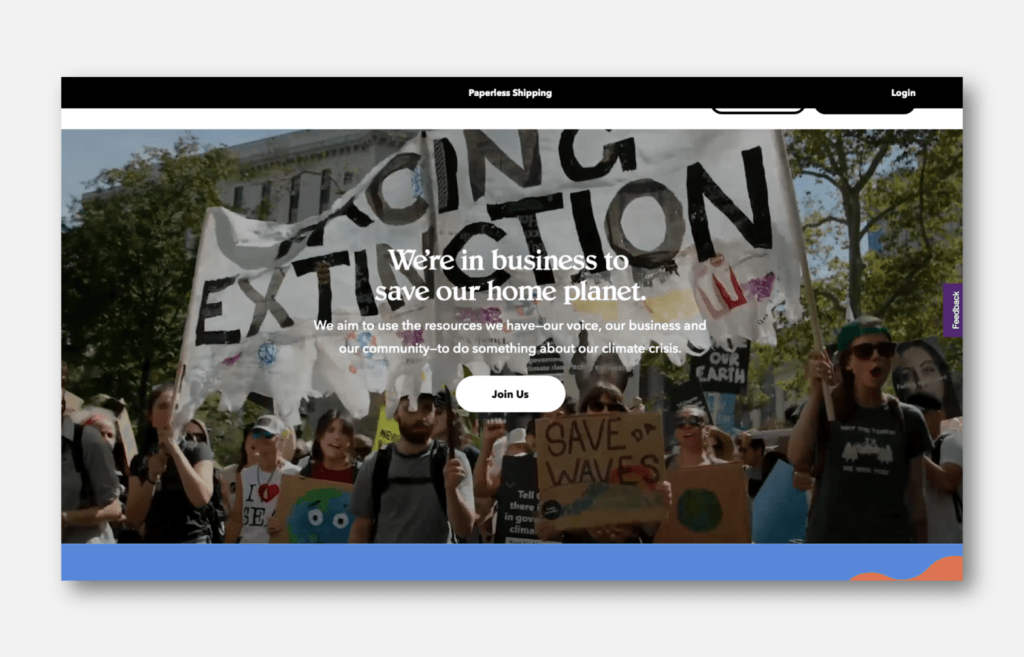Foreword
Before we dive in, I think it’s important to note that digital marketing in itself can have an impact on the environment. The average webpage produces 1.76g of Co2 per page view, meaning brands should be considering more eco-friendly practices across their websites. They should be making them more responsive, easier to navigate and quicker to load with green web hosting and eco-friendly design. This will save navigation time, and in turn save energy. For a great place to start, I recommend Rachel’s Core Web Vitals guide.
Should you wait until you’re perfect before taking a stance?
Nearly 6 in 10 consumers are willing to change their shopping habits to reduce their environmental impact, so the ecommerce brands that are able to communicate their sustainability practices most effectively stand to gain a significant competitive advantage.
No one has all of the answers – but that’s not an excuse for inaction. Most companies are testing and learning along their journey to a sustainable future. It’s imperative that these efforts and valuable learnings are shared because ultimately, the better the communication, the faster the progress. Customers don’t expect perfection, however they do value commitment and transparency.
1. Always tell the truth
Nearly 90% of UK consumers cite that transparency is one of the main ways a company can earn their trust. Quite simply, consumers want brands to be honest, both about their credentials and their sustainability journey.
Many brands worry about greenwashing – the idea that they are giving a false impression of being environmentally friendly, rather than actually taking the action to be so. Customers can spot insincerity and the repercussions can be damaging. So if you’re going to promise to take action on something, then you should be consistently updating customers on your efforts too.
Messages that contain evidence are more believable, and measurable statements or claims are usually preferable to messages of intent. As Olivia mentioned in her recent blog, brands have a corporate social responsibility and there’s a growing expectation from consumers for them to be more accountable.
2. Align your content with your wider purpose and values
Your content needs to have a purpose, and as Abbey mentioned in her previous blog, adopting a cause without evaluating its role in the wider business leaves customers feeling apathetic. Try to focus on the benefits and the impacts you’re hoping to make, and ensure your brand values are consistently conveyed in everything you produce.
We help GLL integrate their CSR values and pillars – which include things like “better communities” and “better people” – into all their content:

To do this authentically, it’s important to work alongside trusted storytellers and content marketers. Communicating your objectives and values early on means we can work with you to keep sustainability at the forefront of your ecommerce strategy.
3. Audit your sustainability content and create a plan for optimisation
As a first step to content optimisation, we’d recommend carrying out a detailed audit of your current sustainability related content, as well as some keyword research to see what your customers are already searching for on the topic. A competitor analysis of ranking websites will also be useful in helping you see what others are currently saying.
With 88% of consumers wanting to shop for brands that help them live more sustainably, a solid content strategy is a must. And a bonus here is that this research may also uncover some opportunities for new product development, depending on the demand.
4. Match your content with a clear hierarchy of messaging
As an ecommerce retailer, you can afford to put much more detail online, and prioritising this user journey can have a sizable impact on the decisions shoppers make.
This information shouldn’t just be relegated to one webpage. Instead, we recommend planting sustainability stories and messages throughout all of your content marketing and across your website, including product and category descriptions.
Hunter has a dedicated sustainability hub for its “Hunter Protect” manifesto for example, made up of 7 pledges and pillars that are fundamental to its brand. It believes that to continue developing its legacy it needs to preserve and restore the forests it relies upon, and optimising content on their CSR hub as well as on their category and product pages helps promote that.

5. Pay attention to product descriptions to reduce returns and minimise waste
A surge in ecommerce has caused returns to increase dramatically. Each year, billions of pounds of returned goods end up in landfills and around 15 million metric tons of carbon dioxide are emitted in their transportation.
Returns are not only a waste of energy, but also a waste of resources that could be better allocated in other areas to improve a retailer’s profit margins.
Accurate product descriptions are a great way to minimise returns and reduce waste. A survey by Yotpo, found that product descriptions not matching the item caused 39% of shoppers to return products.
For example, Bravissimo make bra fitting and sizing as simple as possible with a helpful guide featuring FAQs, relevant imagery and product links so customers can make the right choice first time.

For more information on optimising for fewer product returns, I recommend taking a look at Gary’s blog on why measuring returns is just as important as taking stock of sales.
6. Don’t overcomplicate it
When it comes to communicating your focus on sustainability in ecommerce, there are two key reasons why your strategy may fail to work: a lack of engagement and a lack of transparency.
Great copy can solve both of these issues by making sustainability a topic that’s both approachable and relatable. Quite often, consumers can feel overwhelmed at the scope of the climate crisis and unclear on how purchasing from a brand contributes to any change. Retailers should make the discussion feel incremental, rather than revolutionary – I recommend using layman’s terms and focusing on everyday choices.
Finally, be concise. Today’s consumers digest information in small bites, so how you deliver your message is important. It all needs to feel accessible, clear and interesting. Avoid over-intellectualising sustainability narrative and don’t overcomplicate a product’s sustainable benefits.
The Girlfriend Collective is a great example of a company that puts sustainability at the heart of everything it produces. You don’t have to spend hours digging for information on their policies and practices; it’s clear in all of their content and they’re transparent with the facts.

7. Use alternative means to tell your story
Incorporating clear photography, illustrated guides, animations, tools and videos are all engaging ways to inspire and spread the message of sustainability online.
For example, you could create a series of explainer videos that outline your eco-friendly business practices. If you make the switch to biodegradable packaging, you could create a short clip that teaches customers about how to dispose of it correctly. You could even highlight which products in your collection are sustainable with icons.
A benchmark for sustainability ecommerce, Patagonia know how to tell a story. Their website features pieces on activism from across the world, using great video and photography to set the scene.

Conclusion
The climate crisis is the singular biggest global challenge facing our generation today and ecommerce companies have a crucial part to play in driving change.
The environmental impact of ecommerce is not purely digital and the products being sold will nearly always have a far bigger impact than digital technology, however with ecommerce acting as an accelerant to consumption, it is important that the sector tackles this head on by communicating, educating and involving customers throughout their journey.
“The problem is immense, but we already have the knowledge and skills to halt and reverse it” – Sir David Attenborough
If you’d like more advice on how to build a more sustainably sound ecommerce website, you can contact us here.
